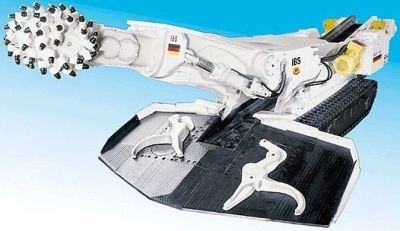 | ||
A roadheader, also called a boom-type roadheader, road header machine, road header or just header machine, is a piece of excavating equipment consisting of a boom-mounted cutting head, a loading device usually involving a conveyor, and a crawler travelling track to move the entire machine forward into the rock face.
Contents
The cutting head can be a general purpose rotating drum mounted in line or perpendicular to the boom, or can be special function heads such as jack-hammer like spikes, compression fracture micro-wheel heads like those on larger tunnel boring machines, a slicer head like a gigantic chain saw for dicing up rock, or simple jaw-like buckets of traditional excavators.
History
The first roadheader patent was applied for by Dr. Z. Ajtay in Hungary, in 1949. It was invented as a remote operated priapic miner for exploitation of small seam, close walled deposits, typically in wet conditions.
Types
Cutting Heads:
Uses
Roadheaders were initially utilized in coal mining applications, however they are now used in a broad range of applications including but not limited to tunneling both for mining and municipal government projects, building wine caves, and building cave homes such as those found in the Coober Pedy area of Australia.
During the initial events of the 2016 Ottawa sinkhole the CBC reported that one of Rideau Transit Group’s three 135-tonne roadheaders was in the LRT tunnel, where the flooding was the deepest. There three roadheaders used in the construction of the O-Train.
